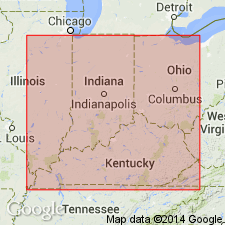
- Usage in publication:
-
- Shanks Quarry Member
- Modifications:
-
- Named
- Dominant lithology:
-
- Limestone
- Dolomite
- AAPG geologic province:
-
- Cincinnati arch
Summary:
The Louisville Limestone at its type locality in north-central KY and in southern IN is here divided into three newly named members (ascending): Big Rock, Shanks Quarry, and Cross Hill. Shanks Quarry consists of 11 ledges whose names are taken from the terminology of the original quarrymen. Big Flag and Little Flag ledges at the base have been combined in this paper as Dual ledge. Above the Dual are the Paving, Blue Captain, 22 inch, Hard Curb, Hard, Big Blue, 7 Foot (incl. Flint Flagging ledge and Three to Five Foot ledge), Oyster, Gray, and Top Blue ledges. As defined here, the Shanks Quarry includes units 4-16 of Butts (1915). The dominant lithologies of the unit are worm-burrowed limestone, dolomite, and dolomitic limestone, and cherty limestone. Thickness ranges from 29 to 48 ft and averages 40 ft in the Louisville, KY, and Sellersburg, IN, areas. Thins rapidly to the east and northeast from its type locality. Member is absent at Prospect Hill in eastern Jefferson Co. as is the overlying Cross Hill Member and the Jefferson Dolomite rests unconformably on the Big Rock Member. Age is Middle Silurian.
Source: GNU records (USGS DDS-6; Reston GNULEX).
For more information, please contact Nancy Stamm, Geologic Names Committee Secretary.
Asterisk (*) indicates published by U.S. Geological Survey authors.
"No current usage" (†) implies that a name has been abandoned or has fallen into disuse. Former usage and, if known, replacement name given in parentheses ( ).
Slash (/) indicates name conflicts with nomenclatural guidelines (CSN, 1933; ACSN, 1961, 1970; NACSN, 1983, 2005, 2021). May be explained within brackets ([ ]).

